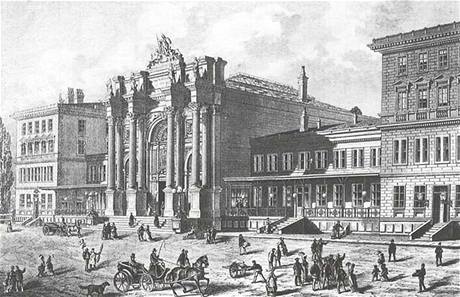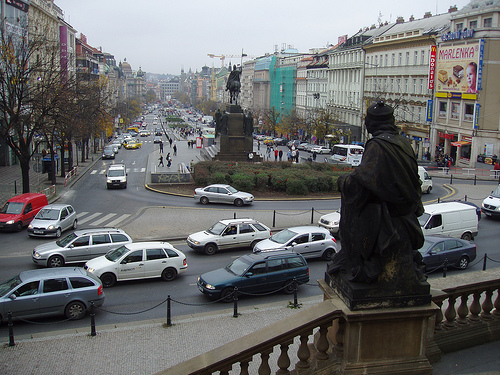 It has been 25 years since the most beautiful railway station in Central Europe was shamelessly destroyed by the Czech communist government. The Tesnovske station (formerly called Denisova station) was replaced by a horrendous highway which now runs right through Wenceslas Square – the heart of the historical center of Prague (see image below). How could the communists be so insensitive? Well, the railway station was not as productive as the very functional planned freeway – that is why. It fits perfectly with the communist ideology. “The communists considered historical buildings to be a backsliding architectural style. Such structures were symbols of bourgeoisie and the communists hated them,” explains Zdenek Lukes, the architectural historian.
It has been 25 years since the most beautiful railway station in Central Europe was shamelessly destroyed by the Czech communist government. The Tesnovske station (formerly called Denisova station) was replaced by a horrendous highway which now runs right through Wenceslas Square – the heart of the historical center of Prague (see image below). How could the communists be so insensitive? Well, the railway station was not as productive as the very functional planned freeway – that is why. It fits perfectly with the communist ideology. “The communists considered historical buildings to be a backsliding architectural style. Such structures were symbols of bourgeoisie and the communists hated them,” explains Zdenek Lukes, the architectural historian.
The royal-looking station looked like the entrance to the city. The architect, Karl Schlimp, incorporated a monumental Roman archway together with Corinthian columns and beautiful ancient statues. The trains were happily using the station until 1972 and then it became a ghost town for some time. The first plans were to create a railway museum there or a new place for various fashion shows. When the highway plans started to come up onto the surface there was also an idea to turn the building 90 degrees so that it would run parallel to the highway.
 Tesnov’s unfortunate destiny was decided – the building was mercilessly going down. Many Czech architects wanted to keep at least a memento of the historical building in a form of an archway but that did not happen either. The building was blown up the 16th of March, 1985.
Tesnov’s unfortunate destiny was decided – the building was mercilessly going down. Many Czech architects wanted to keep at least a memento of the historical building in a form of an archway but that did not happen either. The building was blown up the 16th of March, 1985.
CZ: Je tomu jiz 25 let, co bylo v Praze zbourane nejhezci nadrazi ve stredni Evrope. Komuniste se totiz zbavili teto ‘neprakticke’ budovy kvuli vystavbe – dnes legendarne ohyzdne – severojizni magistraly. Proc se nad timto nadhernym Tesnovskym nadrazim komuniste neslytovali? “Komunisti povazovali historismus za upadkovy styl. Tyto stavby pro ne byly symbolem burzoazie a nesnasely je,” rika historik architektury Zdenek Lukes.
Trojkridla budova postavena v letech 1872-1875 pripominala triumfalni branu do mesta. Architekt Karl Schlimp zakomponoval do cela budovy obrovsky rimsky oblouk lemovany korintskym sloupovim a nekolika rimskymi sochami. Nadrazi bylo vesele v provozu az do roku 1972, kdy ztratilo svuj dopravni vyznam. Pak v Praze sedelo opustene nekolik let. Jelikoz tam ale zustaly koleje, premyslelo se o zrizeni zeleznicniho muzea, nebo o vytvoreni prostoru pro konani modnich prehlidek. Kdyz se ukazalo, ze dalnicni magistrala vyhraje, architekti chteli rozlehlou budovu pootocit o 90 stupnu, aby byla s novou silnici rovnobezna.
Nic z toho se ale nezrealizovalo, misto toho bylo nadrazi 16. brezna roku 1985 zbourane a rimske oblouky nahradila 3-proudova sediva dalnice. Komunisti opet zabovovali.

Source: http://byznys.lidovky.cz/nejhezci-nadrazi-stredni-evropy-si-cesi-zbourali-kvuli-silnici-ps5-/ln-doprava.asp?c=A100316_094515_ln-doprava_nev
If you liked this post buy me a coffee! (Suggested:$3 a latte $8 for a pound) Thanks!




Very interesting post Tanya. I am shocked to read this because if there is one thing, and only one thing, Communists seemed good at it was public transport. It’s especially sad to read this knowing freedom would come four years later. So did Hlavní Nádraží replace this train station? It seems much older than 1985. Were there two in such close proximity? I too agree that highway in front of the National Museum is an abomination.
Wow! That’s a bit of Prague history I never knew about, though I must have walked or driven past the site a thousand times. Are you old enough to remember it personally? With Masarykovo that would have been three major stations within a few minutes’ walk of each other.
First I went back to Praha for a visit, I stood in front of McDonalds restaurant at the top of “Vaclavak” and couldn’t believe that it was impossible to cross the street to visit Kralovske Vynohrady, skolu “na Smetance” a Rygracek kde sem vyrost.
Later, I learn that it was a lot easier to take a subway. I don’t think there is a better public transportation in Europe. That was the ONLY thing the communists were good for. Mike
To Karen: I am glad you enjoyed it! I was a little afraid I would bore people with a lesson in history 🙂
I don’t think anything replaced the Tesnovske nadrazi. The already existing Hlavni nadrazi just took over. From the picture above it seems like it was located somewhere around the current Smetana theatre??
The article said that after 1972 the station was no longer in use but the writer does not explain why!
All these ‘nerdy’ questions…;)
To MiGrant: Yes, I was 6 when the building was destroyed but I don’t remember hearing seeing anything (but then again, at that age, I only cared about my dolls and ice cream).
The article said that this station would have been the second oldest in Prague so I assume that Masarykovo nadrazi is the oldest.
To Mike: Mike, I also grew up around that area!!! That road is impossible to cross but we still would used to try to run across it (by the National Museum location)instead of using the underground tunnel. How dumb and dangerous of us!
Very interesting article! I never knew about this railway station. How sad. However I am not surprised that this happened during communism. I grew up in Most and they destroyed the ENTIRE city (Stary Most)because of coal. The only things left are a church and a fountain. They took the church apart and moved it a few hundred meters to save it. I personally don’t remember that city but everyone who does says that it was absolutely beautiful and the loss is tremendous.
Cau, ja jen udelal takovou malickou revizi cestiny 😀
CZ: Je tomu jiz 25 let, co bylo v Praze zbourano nejhezci nadrazi ve stredni Evrope. Komuniste se totiz zbavili teto ‘neprakticke’ budovy kvuli vystavbe – dnes legendarne ohyzdne – severojizni magistraly. Proc se nad timto nadhernym Tesnovskym nadrazim komuniste neslitovali? “Komunisti povazovali historismus za upadkovy styl. Tyto stavby pro ne byly symbolem burzoazie a nesnasely je,” rika historik architektury Zdenek Lukes.
Nic z toho se ale nezrealizovalo, misto toho bylo nadrazi 16. brezna roku 1985 zbourano a rimske oblouky nahradila 3-proudova sediva dalnice. Komuniste opet zabodovali.
One more time: Oldes trainstation in Prague is Praha – Dejvice from 1831 but in that time it wasnt in area of Prague. First Prague trainstation was Praha Masarykovo nádraží from 1845. And my opinion is that there was only one thing which was good on communism – limitation of religions. BTW something similar to communism will come this May – Jiri Paroubek.
Mileno, for a while I also lived in MOst (sidliste) and we would take walks in the old Most village so I know exactly what you are talking about.
My mother was from Most and I saw part of the town before the final tear down in August 1968. Sad for many to see their home town gone forever. I was writing with a town historian for awhile. She sent me a nice book about old Most, called Zmizely Most Pub. 2003
You do a fantastic job with his blog Tanja. I really enjoy it.
Nerad bych se mylil,ale mam za to,ze tesnovske nadrazi bylo zbourano uz v 70.tych letech.
Ahoj Tanjo,
Ja si tu budovu pamatuji. Chodivala jsem okolo s moji maminkou. Take jsme tam nekde pobliz cekali na tramvaj, kdyz jeste jezdily pres Vaclavak a kupovali jsme si tam oriskovou zmrzlinu tocenou v kornoutku. Jedna budova a to se cloveku vybavi veci na jednou:)
Aha, tak to by vysvetlovalo to, ze si to nikdo nepamatuje 😉 Clanek v lidovkach rika, ze to bylo v roce 1985.
Marika si to pamatuje! Tak v jakem roce jsi tam kolem te budovy chodila? Kdy byla zborena?
Toto zbourani nema nic spolecneho s komunisty. Komunisti (napr v SSSR) vrazdili sve spoluobcany,
budovali koncentraky, atd…
Ale komuniste si taky prisvojili nektere uspechy svych architeku kteri mozna ani nebyli komunisti, ale schopni lide, kteri nektera tato dila vytvorili…
Proto bych to nehazel na komunisty , ze zbourali nadrazi. Vystavba dalnice nebyla politicka a zbourani nadrazi byl jen dusledek rozhodnuti nejakeho blba, ktery zustak blbem i v dnesnim rezimu.
Komunisti, kteri meli ruce od krve, mely jine starosti, nez bourani nejakych baraku…
V New Yorku byl malem zbouran skvost Grand Central Station a byla zbourana Penn Station, a malem byla zbourana pekna posta stojici hned vedle toho nadrazi…
Mimochodem, dalnice vedouci pres mesto neni ve svete vyjimkou.. A vsechny dalnice jsou ohyzdne. A vsichni chteji jezdit po dalnici, ale hlavne je nejdulezitejsi, aby ta dalnice nevedle zrovna kolem JEHO baraku…
Historicke pamatky se taky nicili pri stavbach prehrad, nehlede na to, ci to staveli komunisti nebo kapitalisti. Tyto “zlociny” byly spachany v zajmu civilizace, kterou porad “kapitalisti” a “komunisti” se snazili zlepsovat.. Komunistum ale dosel dech, a jejich rezim spadnul jako domek z karet… Mozna i to nadrazi by spadlo samo, protoze by bylo v desolatnim stavu,, presne tak ,jako byl v desolatnim stavu Grand Central Station v NYC.
Rad bych vedel, co ted delaji lide, kteri rozhodli o zbourani toho nadrazi. Jestli jeste pracuji, (asi uz ne) tak by se meli odstranit od remesla, protoze takovi lide budou pachat skody nehlede na rezimu…
No jo, ale vzdyt ta dalnice ani neni dalnice, je to triproudova uprdena cesta, ktera je neustale zacpana. Proc neudelali treba 5ti proudou dalnici ZA muzeem nebo nekde v podzemi??
Tanja, existuje projekt, ze tuto “dalnici” ve stredu mesta daji do podzemi, je to jeinecny projekt ale bude to tezke uskutecnit..Dalnice se nesmi krizovat s metrem :)))
Ale no tak nejaky ten semaforek by se tam dal a metro s auticky by se dohodlo…;)
No asi vsude, v jakemkoliv rezimu se najde debil co zbori neco krasneho a postavi neco ohyzdneho, ale zbourani teto budovy je prisuzovano komunistum asi proto, ze tomu neslo skoro nijak zabranit. Nejaky pamatkovy urad, pamatkari, tehdy neexistovali. A byl to prave komunismus, ktery se negativne podepsal na ruznych pamatkach. Sklady bordela v kostelech, beton do stredovekych staveb – jen spicka ledovce 🙂
multi.flexi, s tim betonem mas pravdu, aby se usetrilo, tak za komunistu byl Karluv most prave znicen tim, ze do neho nalevaly beton….
It’s positively criminal to destroy such a gorgeous building!! I was in Prague a couple of years ago and did not know what a treasure had stood there! Thanks for sharing this bit of architectural history, especially the pictures.